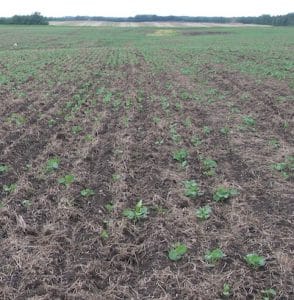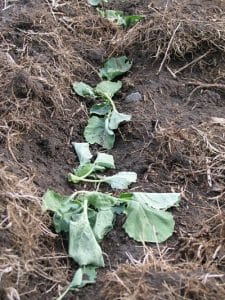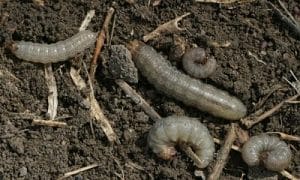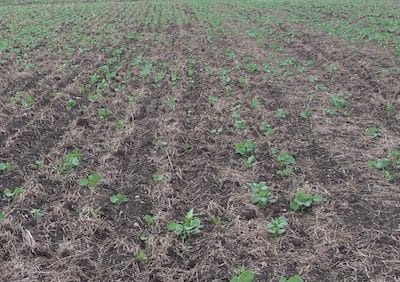Cutworms outbreaks are hard to predict and numbers can vary significantly field to field. It often has to do with adult attractants at the time of egg laying. In general, fields that had flowering plants (crops or weed patches) in August or September of the previous year may have higher cutworm counts. These flowers attract the adult moths, which lay their eggs in these areas. Females also prefer loose worked soil for egg laying.
Weather conditions can influence the survival of overwintering eggs and larvae. In southern Alberta, for example, the winters of 2014-15 and 2015-16 were unusually mild, which meant high winter survival. Wet springs can increase cutworm mortality due to pathogens, but this tends to affect those species that overwinter as larvae more than those that overwinter as eggs. The most common species in Western Canada – redbacked and pale western – overwinter as eggs, and may not be as susceptible to saturated soils.



Why scout?
Reason one: To confirm that cutworms are the cause. For example, fungal seedling diseases can cause seed and seedling decay that can lead to patches of missing plants. While scouting around patches, check roots and seeds for signs of rot and infection. Note that cutworms often clean out all the plants and weeds in a patch, while disease may be more plant specific. Mechanical problems with the drill can lead to missing rows, and while it might seem obvious to identify a mechanical issue, cutworms will often follow along the loose worked soil of seed row. Read more.
Reason two: To identify the cutworm species present as this can influence management decisions. Underground-feeding cutworms are less likely to encounter spray, for one thing. Pale western cutworms are primarily subterranean feeders, which means a systemic product such as a seed treatment may provide the best protection. And thresholds vary by species. Black cutworm threshold for canola is 25-30% stand reduction, which had been the nominal threshold for all species. Redbacked and pale western threshold for canola is 4-5 larvae/m2. For lots more on species identification, use AAFC’s Cutworm Pests of Crops on the Canadian Prairies or read this Canola Watch article.
When to scout?
Include cutworms on the scouting checklist for the first one to three weeks after emergence. Any later and management becomes more difficult because (i) spraying a registered insecticide is useless because the cutworms have developed beyond the feeding stage, and/or (ii) reseeding options are starting to be limited.
Scout late in the day or extremely early in the morning to look for above-ground feeding cutworms. During the day, cutworms usually go back underground.
How to scout?
Look for bare areas, holes and notches in foliage, and plants that are wilting, toppling over or completely cut off. Bare spots will begin to appear within the field, typically on south facing slopes and hilltops where the soils are warmer and soil texture is lighter. Cutworms often move through the loosest soil, which is why they tend to move along seed rows.
Start scouting at the edge of patches or around the last living plants within patches. This is where cutworms, if present, will be feeding. Dig up the soil around the base of living plants at patch edges, collecting soil from a 50 cm by 50 cm area to a depth of 5 cm. Put the soil into a basin, loosen and shake it up to activate cutworms. Larvae often curl up or attempt to hide in the debris when exposed. Count the number of larvae then multiply by four to estimate the number of larvae per m2. Repeat this process 5 to 10 times at 50 m intervals, including at low, side-slope and high parts of the field. Note that cutworms are often just above the moisture in the soil, so if it has been hot and dry, digging to 7.5cm (~3”) may be worthwhile. Any place birds gathered on the ground in a field is a suspicious cutworm scouting point.
Considerations for the spray decision
1. Are cutworms still actively feeding? Put flags in the ground at the edges of a patch. Check the next day to see if the bare patch of missing plants has expanded beyond that flag.
2. Size and lifecycle. Larger cutworms (1 to 1.5 inches long) will be closer to the end of their larval stage. When they pupate, they’re done eating. The risk in trying to estimate this lifecycle stage is that cutworms do most of their eating in that final instar. In warm conditions, it can take 4 to 6 days for cutworms to grow through the final instar. They can do a lot of damage in that time.
3. How much damage can they do in a day? A cutworm can kill a young canola plant in a few minutes by cutting through the stem at or below the soil surface. Species of cutworm that crawl up on plants to feed may eat leaves, but not kill the plant unless plants are very small or cutworm numbers are very high. Weather also influences how much they’ll eat. While metabolism slows in cool weather, they will still feed a bit. But that also could mean they live longer between instar cycles.
4. Gut colour. Cutworms stop feeding while molting between instars and as they are about to pupate. Squeeze a bunch of them. Green insides indicate active feeding. Brown insides indicate they’re not feeding. While insecticides work through contact or ingestion, cutworms do have to surface to be controlled. If they’re not eating, they may stay underground. However, residual activity of most registered products should get them when they start feeding again. For example, in a study where 50% and 34% of pale western cutworms were in a molt at the time of application, by 7 days later the pyrethroid that was used killed 81% and 84% of the cutworms (Hill, Byers, and Schaalje. 1992: J. Econ. Entomol. 1387-1392). Do some follow-up scouting, but stick to thresholds the second time. A few living cutworms found in the few days after an application may not indicate a need to spray again.
5. Beneficials. Most cutworm species are native to North American so have many natural enemies — including insects and diseases caused by fungi, bacteria and viruses — that provide population control. Waiting for these to take action may not be a wise decision if numbers are at thresholds and the crop is at immediate risk, but letting nature take its course when numbers are below threshold is usually the best decision. A farmer should never spray for population control reasons. Stick to threshold-driven decisions to protect the crop only. As Alberta Agriculture entomologist Scott Meers says, “Lots of things control population. Spray is not very good at it.” Also, spraying now will not reduce populations for next year because that population is based on adult egg-laying later in the season and adults (moths) are very mobile.
Spray strategies
For specific requirements on water volume, rates, timing, restrictions and product activity, read the label for the chosen product. Some products are systemic insecticides that are taken up into the plant’s tissues and work when the insect eats portions of the plant. Contact products work best when the insect is sprayed directly. Products have varying amounts of residual activity — some very little, some up to two weeks. Again, check labels or talk to retailers if information on residual is hard to find.
Time of day to spray. Cutworms surface at night to do their above ground feeding. For a contact-driven product such as lambda-cyhalothrin (Matador/Silencer), spraying as close to nightfall as possible will improve results. Synthetic pyrethroids (Decis, Matador/Silencer, for examples) further benefit from late-day spraying because they should be applied when temperatures are below 25°C. A systemic product with a long residual, such as Coragen (which has “translaminar” movement into the leaf or stem), can be applied during the day. Since not all cutworms will surface on a single night, it may take several days before full effect of a residual insecticide is achieved.
Water volume. For all products, 10 gallons is the recommended minimum water volume and higher is often better for coverage of leaves and stems. The more plant surface area covered, the more likely that cutworms will take in the insecticide.
Further reading:
Cutworm Pests of Crops on the Canadian Prairies. PDF
Manitoba cutworm factsheet
Canola Watch cutworm quiz

